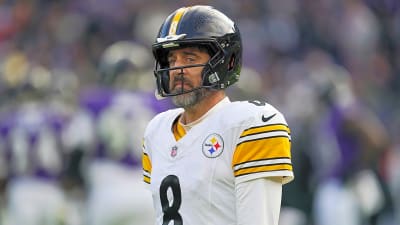- Home
- Quizzes
- My Quiz Activity
- Newsletters
- MY FAVORITES
- Add Sports/Teams
- SPORTS
-
NFL
- NFL Home
- Arizona Cardinals
- Atlanta Falcons
- Baltimore Ravens
- Buffalo Bills
- Carolina Panthers
- Chicago Bears
- Cincinnati Bengals
- Cleveland Browns
- Dallas Cowboys
- Denver Broncos
- Detroit Lions
- Green Bay Packers
- Houston Texans
- Indianapolis Colts
- Jacksonville Jaguars
- Kansas City Chiefs
- Las Vegas Raiders
- Los Angeles Chargers
- Los Angeles Rams
- Miami Dolphins
- Minnesota Vikings
- New England Patriots
- New Orleans Saints
- New York Jets
- New York Giants
- Philadelphia Eagles
- Pittsburgh Steelers
- San Francisco 49ers
- Seattle Seahawks
- Tampa Bay Buccaneers
- Tennessee Titans
- Washington Commanders
-
MLB
- MLB Home
- Athletics
- Arizona Diamondbacks
- Atlanta Braves
- Baltimore Orioles
- Boston Red Sox
- Chicago White Sox
- Chicago Cubs
- Cincinnati Reds
- Cleveland Guardians
- Colorado Rockies
- Detroit Tigers
- Houston Astros
- Kansas City Royals
- Los Angeles Angels
- Los Angeles Dodgers
- Miami Marlins
- Milwaukee Brewers
- Minnesota Twins
- New York Yankees
- New York Mets
- Philadelphia Phillies
- Pittsburgh Pirates
- San Diego Padres
- San Francisco Giants
- Seattle Mariners
- St. Louis Cardinals
- Tampa Bay Rays
- Texas Rangers
- Toronto Blue Jays
- Washington Nationals
-
NBA
- NBA Home
- Atlanta Hawks
- Boston Celtics
- Brooklyn Nets
- Charlotte Hornets
- Chicago Bulls
- Cleveland Cavaliers
- Dallas Mavericks
- Denver Nuggets
- Detroit Pistons
- Golden State Warriors
- Houston Rockets
- Indiana Pacers
- Los Angeles Clippers
- Los Angeles Lakers
- Memphis Grizzlies
- Miami Heat
- Milwaukee Bucks
- Minnesota Timberwolves
- New Orleans Pelicans
- New York Knicks
- Oklahoma City Thunder
- Orlando Magic
- Philadelphia 76ers
- Phoenix Suns
- Portland Trail Blazers
- Sacramento Kings
- San Antonio Spurs
- Toronto Raptors
- Utah Jazz
- Washington Wizards
-
NHL
- NHL Home
- Anaheim Ducks
- Boston Bruins
- Buffalo Sabres
- Calgary Flames
- Carolina Hurricanes
- Chicago Blackhawks
- Colorado Avalanche
- Columbus Blue Jackets
- Dallas Stars
- Detroit Red Wings
- Edmonton Oilers
- Florida Panthers
- Los Angeles Kings
- Minnesota Wild
- Montreal Canadiens
- Nashville Predators
- New Jersey Devils
- New York Islanders
- New York Rangers
- Ottawa Senators
- Philadelphia Flyers
- Pittsburgh Penguins
- San Jose Sharks
- Seattle Kraken
- St. Louis Blues
- Tampa Bay Lightning
- Toronto Maple Leafs
- Utah Mammoth
- Vancouver Canucks
- Vegas Golden Knights
- Washington Capitals
- Winnipeg Jets
- NCAAF
- NCAAM
- Olympics
- Boxing
- Entertainment
- Lifestyle
- Golf
- MMA
- Soccer
- Tennis
- Wrestling
- Sports Betting
- More Sports
- RESOURCES
- My Account
- YB on Facebook
- YB on Twitter
- YB on Flipboard
- Contact Us
- Privacy Policy
- Terms of Service
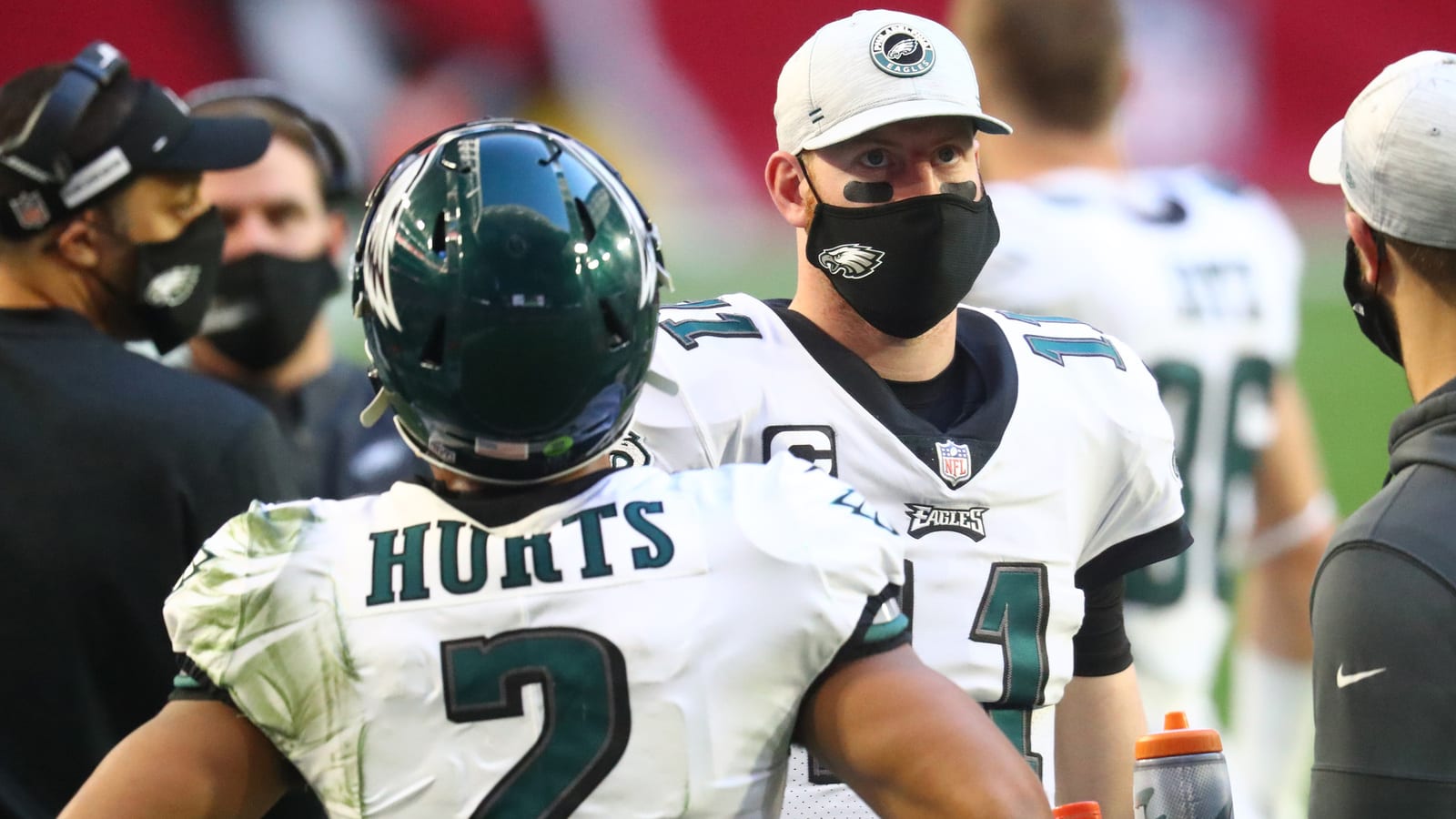
The most memorable NFL QB benchings
The Panthers' Bryce Young demotion came historically quick for a highly drafted quarterback, but other top prospects have endured similar fates; high-profile veterans, too. With an aim to avoid injury-related changes or one-off demotions in which the player returned to action soon after, here are the NFL's most memorable quarterback benchings.
Atlanta Falcons: Kirk Cousins for Michael Penix Jr. (2024)
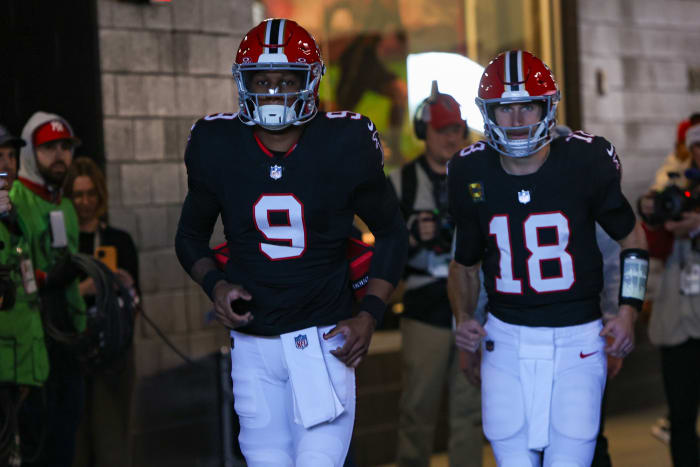
The Falcons stunned most by drafting Penix eighth overall six weeks after giving Cousins $90 million guaranteed. No team had completed a comparable QB double-up in one offseason in the free agency era, affixing eyes to the situation throughout the season. While the Falcons' previous two QB depth charts did not move the needle, this one featured the team backtracking on a hasty plan. Cousins' struggles prompted Raheem Morris to bench him, some would argue too late, to go with Penix in hopes of providing a spark. Top-10 QB picks continue to see rookie-year playing time, in almost all cases, and Penix supplanting Cousins will lead to the Falcons taking a dead money bath by cutting the veteran.
Carolina Panthers: Bryce Young for Andy Dalton (2024)

The Panthers gave Young all of 18 starts before they sat him. As rumors swirled about Young being heading to the trade block, this marked a historic about-face from a team that both traded the farm for Young in 2023 and then centered its 2024 offseason on developing him. An interesting thing happened as Young toiled on the bench; a Dalton car accident led him back onto the field. Dalton suffered minor injuries, as he his family were involved in the wreck, and Young showed signs of life for the first time as a pro. The 2021 Heisman winner returned to make 10 start, throwing eight TD passes and zero INTs over the final three Carolina games. He is back in place as the Panthers' long-term hopeful.
Las Vegas Raiders/Denver Broncos: Jarrett Stidham becomes contract protection

Stidham has settled into an interesting niche, being used twice as the starter teams have turned to in an effort to bubble-wrap their expensive QB1s before a divorce. The Raiders ended the Derek Carr era in Week 17 of the 2022 season, turning to Stidham to prevent an injury affecting the longtime starter's contract. The Broncos made the same move at the same juncture a year later, giving Stidham their final two starts over Russell Wilson. The Raiders and Broncos each cut their starters the following offseason, the latter instance producing a record-shattering dead-money sum. Stidham could not beat out Bo Nix for the 2024 Denver QB1 gig.
New York Jets: Zach Wilson for Mike White (2022)
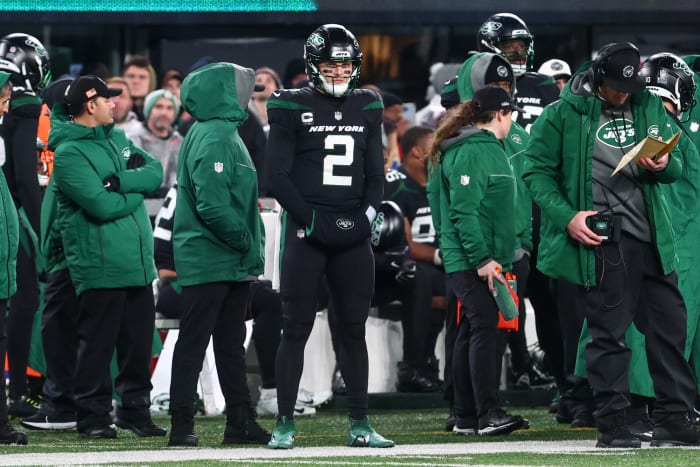
Wilson's pre-draft rise produced an interesting prospect profile. The COVID-19 pandemic led to BYU playing a softer 2020 schedule, and Wilson capitalized en route to becoming the No. 2 overall pick in 2021. Trading Sam Darnold to the Panthers, the Jets did not backstop his successor with a veteran as a potential bridge. They needed one, it turned out. By November 2022, Robert Saleh had a near-mutiny on his hands. He parked Wilson for popular backup White, but a White injury moved the overmatched starter back into action. Saleh then benched him for ex-CFLer Chris Streveler in Week 16. Aaron Rodgers' 2023 Achilles tear keyed a Wilson resurfacing; a third benching commenced.
Philadelphia Eagles: Carson Wentz for Jalen Hurts (2020)
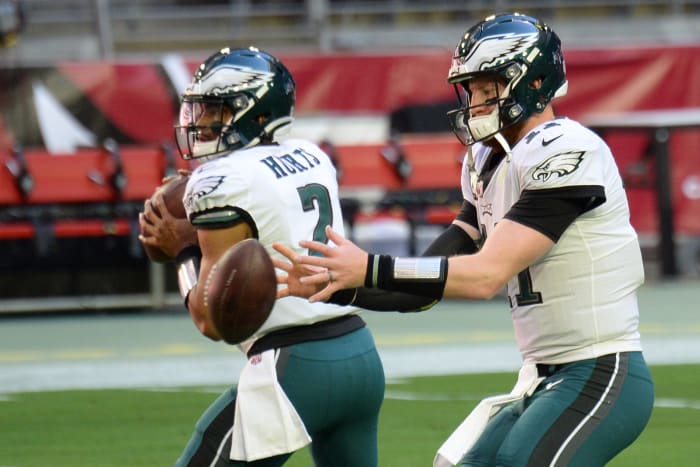
The Wentz-Doug Pederson combination powered the Eagles to the NFC's No. 1 seed in 2017, and only an ACL tear in Week 14 stymied the starter's MVP run. After Nick Foles rescued the Eagles en route to their first Super Bowl title and a Foles statue being erected, Wentz could never recapture his MVP form. While Wentz did pilot Philly to the playoffs in 2019, he struggled in 2020. The Eagles had chosen Hurts as a second-round project of sorts that year, but it soon turned into a changing of the guard. Pederson benched Wentz for the developing Hurts in Week 15. Despite extending Wentz in 2019, the Eagles traded him to the Colts in 2021. Hurts has since won Super Bowl MVP honors.
New York Giants: Eli Manning for Geno Smith (2017)
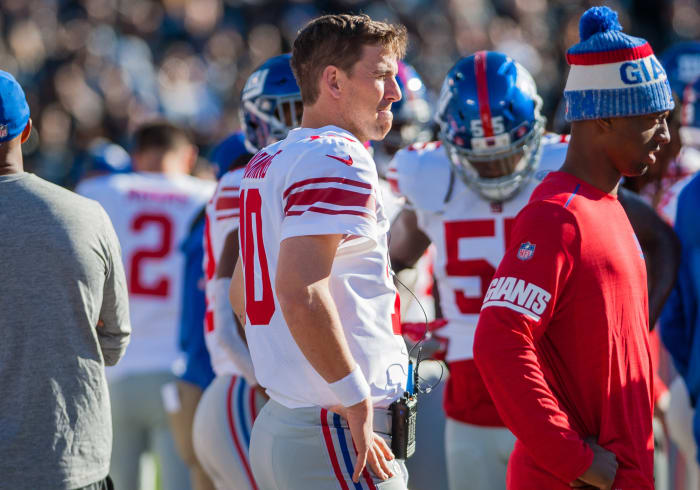
The 2017 season brought two short-term benchings, the second of which produced franchise-changing reverberations. Then-Giants head coach Ben McAdoo benched Manning for a Week 13 Raiders game. This ended Manning's 210-game start streak, the second-longest run by a QB in NFL history -- behind only Brett Favre. Ownership reacted by firing McAdoo and longtime GM Jerry Reese, cleaning house despite the Giants having made the playoffs in 2016. The 2017 New York roster, down Odell Beckham Jr. for most of the season, finished 3-13. Manning was reinstalled as the starter the following week and kept the job until Week 2 of the 2019 season. Smith signed with the Seahawks in 2019.
Buffalo Bills: Tyrod Taylor for Nathan Peterman (2017)

Peterman's two windows as a true NFL starter will live on in box score lore for decades. Taylor was a careful yet productive starter in Buffalo. He had signed a reworked contract in 2017 and had the team at 5-4 going into a Week 11 game against the Chargers. First-year coach Sean McDermott gave Peterman, a fifth-round rookie, the nod anyway. This produced an astounding outcome, with Peterman throwing five INTs before halftime. The Bills moved Taylor back into action out of the locker room. Despite this bizarre benching, Buffalo snapped a 17-season playoff drought. The team traded Taylor to the Browns in 2018 and used Peterman as the Josh Allen bridge. That went poorly, too.
Cleveland Browns: Brian Hoyer for Johnny Manziel (2014)

Normally falling nowhere close to "In the hunt" playoff graphics during the 2010s, the Browns had made their way to 7-4 behind Hoyer. A suburban Cleveland native, Hoyer signed with his hometown team that year and guided the team to that record despite the first of talented WR Josh Gordon's mega-suspensions. Losses in Weeks 13 and 14, however, prompted first-year HC Mike Pettine to bench the veteran for Manziel. Knowing what we know now re: the then-rookie's film-study habits, this benching does well to typify a dysfunctional organization. Months later, OC Kyle Shanahan created a PowerPoint presentation for why he should be let out of his contract. Manziel was out of his by 2016.
Washington: Robert Griffin III for Colt McCoy (2014)

A revelation as a rookie, Griffin famously beat out Russell Wilson and Andrew Luck for Offensive Rookie of the Year acclaim in 2012. The earned honor produced a downer ending, with the flashy Washington QB suffering an ACL tear in a wild-card loss. RG3 did not recapture his form in 2013 and struggled despite both Shanahans, Sean McVay and Mike McDaniel working on that Washington staff. With that coaching array gone in 2014, Jay Gruden benched Griffin for McCoy in Week 13. A fifth-year vet, McCoy was above Kirk Cousins on the depth chart at that point. RG3 made two more starts in 2014, but Washington did not play him a snap in 2015, ushering in the Kirk Cousins period.
Denver Broncos: Kyle Orton for Tim Tebow (2011)
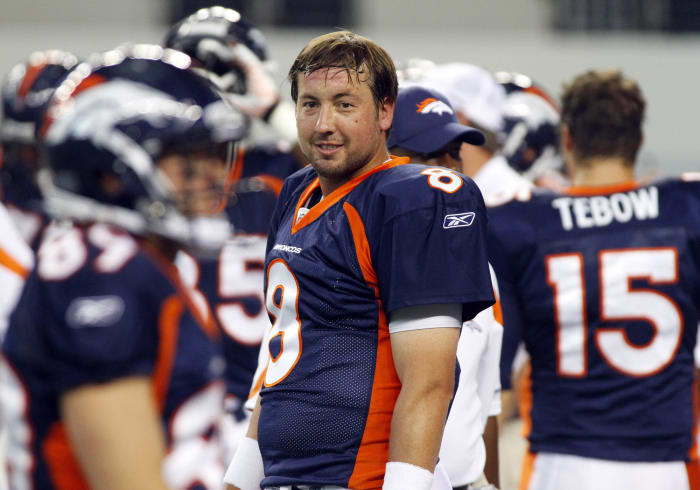
Ridiculed for trading up for the unpolished Tebow in the 2010 first round, HC/de facto GM Josh McDaniels was fired for a videotaping scandal that December. McDaniels' successor John Fox initially kept Orton, the QB acquired in a panned 2009 Jay Cutler trade, as his starter. After a 1-4 start, Fox turned to Tebow. Suspicions of Denver pulling a #SuckforLuck campaign initially emerged, as Tebow was woefully out of place in a pro-style offense. But Denver OC Mike McCoy rejiggered Denver's attack at midseason, leading to a run-oriented group that crept into the playoffs and upset the Steelers in overtime in the wild-card round on a miracle Tebow-to-Demaryius Thomas 80-yard TD pass. Waived in November 2011, Orton ended up beating Tebow as the Chiefs' starter in Week 17. Tebowmania was short-lived, as the Broncos traded him a day after signing Peyton Manning.
Dallas Cowboys: Drew Bledsoe for Tony Romo (2006)

Romo experienced a long run as a Cowboys backup, arriving as a free agent in 2003 while developing behind the likes of Quincy Carter, Vinny Testaverde and Bledsoe. The former No. 1 overall pick joined the Cowboys in 2005 and started throughout that season. Bill Parcells, however, benched the 14th-year vet for Romo at halftime of a Week 6 matchup against the Giants. A former UDFA, Romo had thrown all of two regular-season passes until that game. The former Sean Payton disciple stuck as the Cowboys' starter until a 2016 back injury ushered in Dak Prescott. Bledsoe retired after the '06 season.
St. Louis Rams: Kurt Warner for Marc Bulger (2003)

The MVP in 1999 and 2001, Warner earned Super Bowl XXXIV MVP honors and had signed a lucrative Rams extension. The 2002 Rams started 0-5, however, and Warner dealt with a finger injury that season. In Week 1 of the '03 season, the future Hall of Famer fumbled six times in a loss to the Giants. Mike Martz, Warner's OC in 1999 and his head coach for four seasons, demoted the veteran for Bulger in Week 2. Bulger made the final 15 starts for the Rams, who went 12-4 to earn the NFC's No. 2 seed. The Rams cut Warner in 2004. Benched for Eli Manning after spending the 2004 season with the Giants and seeing the Cardinals draft Matt Leinart to replace him, Warner recovered (though, his movie cuts off before that point).
Pittsburgh Steelers: Kordell Stewart for Tommy Maddox (2002)

All due respect to Rod Smart's "He Hate Me" alias, Maddox was probably the biggest winner from XFL 1.0. Bizarrely drafted in the first round of the '92 NFL Draft by a Broncos team that rostered a 31-year-old John Elway, Maddox was no threat to the Denver legend and out of the NFL by 1997. He sold insurance until gigs in the Arena League and XFL — the L.A. Xtreme QB was league MVP — reopened an NFL door. Stewart's backup in 2001, Maddox usurped the electric but inconsistent starter in Week 4 of the '02 season. Maddox went 10 seasons in between NFL starts but led the Steelers to the divisional round that season, earning Comeback Player of the Year honors.
Cincinnati Bengals: Akili Smith for Scott Mitchell (2000)

JaMarcus Russell and Ryan Leaf receive more heat as draft busts, but Smith was a No. 3 overall pick whose team gave up on him much earlier. Chosen after Tim Couch and Donovan McNabb in a five-QB first round in 1999, Smith sat behind veteran Jeff Blake as a rookie. The Bengals let Blake join the Saints in free agency, turning to Smith. Cincinnati, which had turned down Mike Ditka's monster offer for Ricky Williams in that draft, gave Smith all of 11 starts in 2000 before benching him in Week 11. Mitchell, signed that March, replaced him. Jon Kitna signed in 2001, relegating the former Oregon QB to the bench for good.
Baltimore Ravens: Tony Banks for Trent Dilfer (2000)

Banks bounced from his Rams starting gig to the Ravens, who featured him as their primary 1999 starter. Banks held off Dilfer, a 2000 free agent signing, but could not keep the job as the Baltimore offense stalled at midseason. Brian Billick yanked Banks during a Week 8 loss to the Titans, and Dilfer famously elevated a moribund offense toward a level that gave a menacing defense a fighting chance. The Ravens had failed to score a touchdown in Banks' final four starts. While they were far from a juggernaut with Dilfer, the former Buccaneers top-10 pick piloted the team to an 11-1 record and a dominant Super Bowl win. Both QBs were elsewhere in 2001.
Buffalo Bills: Doug Flutie for Rob Johnson (1999)

Re-emerging after nearly a decade in the CFL, Flutie's folk-hero status took on new life as he became a surprise starter in 1998 and kept up his momentum in '99. Replacing an injured and ineffective Johnson early in the '98 season, Flutie powered the Bills from 0-3 to the playoffs. Following his Pro Bowl season, Flutie started 15 games for a Bills team that went 10-5. Wade Phillips then gave Johnson — whom the team acquired for a first-round pick in 1998 — a start in a meaningless Week 17 game. Buffalo's 31-6 win over a Colts team resting starters led to Johnson staying in the lineup for the infamous (in Buffalo) Music City Miracle wild-card game. Both QBs returned following that historic loss, but this benching defined their Bills run.
Philadelphia Eagles: Randall Cunningham for Rodney Peete (1995)

Cunningham delivered an electric run as an Eagle, taking the reins in 1986 and thriving as a dual threat. Ahead of his time, the athletic talent — an MVP runner-up four times — was at times pigeonholed into pass-oriented offenses. That spelled the end for Cunningham in Philly, with rookie OC Jon Gruden's West Coast Offense ill-fitting for the team's then-starter. As a result, new HC Ray Rhodes benched Cunningham for Peete ahead of the Eagles' Week 5 game. Cunningham made cameos but no more starts the rest of the way. Peete, the ex-Lions QB, engineered a 58-37 win over his old team in the wild-card round. Cunningham retired in 1996 but made a memorable comeback that peaked in Minnesota.
Cleveland Browns: Bernie Kosar for Vinny Testaverde (1993)
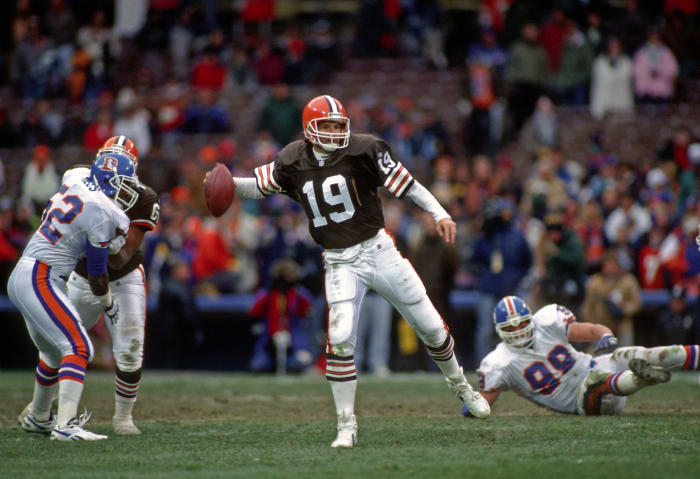
A tipping point in Bill Belichick's Browns tenure came when he severed ties with a Cleveland icon. Then in his third season as Browns head coach, Belichick benched Kosar for Testaverde in multiple early-season games. Before Week 7, the grumpy HC sat Kosar. Testaverde, who could not turn around a woeful Buccaneers team, had signed with the Browns in free agency's 1993 debut. A Youngstown native, Kosar had been Cleveland's starter since 1985. Despite a Testaverde injury shuttling Kosar back into action, Belichick unceremoniously cut the popular passer. Kosar caught on with the Cowboys, starting for Troy Aikman four days after signing. Testaverde remained with the Cleveland-to-Baltimore franchise until 1997.
Washington: Jay Schroeder for Doug Williams (1987)
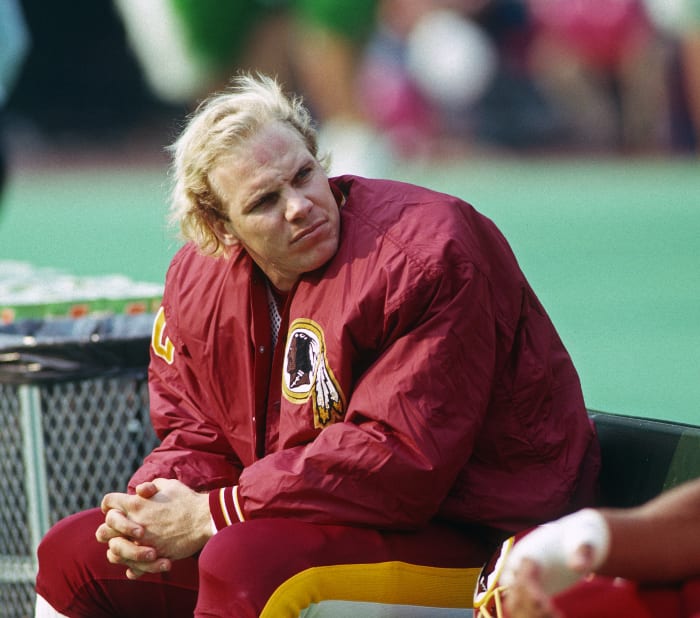
Washington's 1986 team ventured to the NFC championship game behind a Pro Bowl quarterback. Schroeder, a 1984 third-round Washington pick drafted during Joe Theismann's starter run, held the starting job for much of the 1987 season as well. Although a QB controversy spawned between Schroeder and Williams, a former Buccaneers starter back in the NFL after a USFL stay, Joe Gibbs did not make a final decision until Week 16. After Williams relieved Schroeder to help seal a win over the Vikings, he started Washington's three playoff games — the finale a dominant Super Bowl XXII win over the Broncos. Washington traded Schroeder, who fell out of favor with teammates and coaches, to the Raiders in 1988.
Seattle Seahawks: Jim Zorn for Dave Krieg (1983)

The rare QB1 battle featuring two undrafted players commenced in Seattle in the early 1980s. This was more impressive considering the draft stood at 12 rounds when Krieg was not chosen (1980) and 17 when Zorn entered the league (1975). Undrafted out of a college that has since folded (Milton), Krieg nipped away at Zorn's heels and overtook him during part of the strike-shortened 1982 season. But Zorn reclaimed the job in '83. Chuck Knox used Zorn, the Seahawks' starter since the team's 1976 inception, for eight games before pulling him midseason. The Krieg era began in earnest, producing a run to the AFC title game. The eventual 19-year veteran lasted until 1991 as Seattle's starter.
New York Giants: Phil Simms for Scott Brunner (1983)

Known to butt heads, Simms and Bill Parcells did not get off to a good start. Injured throughout the 1982 strike-shortened season, Simms saw the Giants fire Ray Perkins and promote Parcells. Parcells' defining act in his first year: demoting the former top-10 quarterback for Brunner, a 1980 sixth-round Giants draftee. Brunner started all nine Giants games in 1982, but a healthy Simms — then in his fifth season — could not beat him out for the job in Parcells' first training camp. Simms sustained a finger injury upon receiving work as a backup that October, not playing again that season — a 3-12-1 campaign. Parcells and Simms patched things up, and the future CBS mainstay remained a Giant for 10 more years.
Los Angeles Rams: John Hadl for James Harris (1974)

A willing QB trade partner in the 1970s, the Rams laid interesting groundwork for their snazziest haul. Hadl had been a Pro Bowler in 1973, but Chuck Knox decided to bench the veteran for the younger Harris in Week 6 of the '74 season. Oddly, this demotion did not depress the ex-Charger's value. The Packers paid a bounty to acquire the supplanted 34-year-old starter, as an Archie Manning trade had fallen through. Green Bay gave up two first-rounders, two seconds and a third for Hadl, clearing the runway for Harris. A trailblazer as a Black QB, Harris earned Pro Bowl honors after his half-season starting. Ram trades of Roman Gabriel and Ron Jaworski sandwiched the Hadl swap.
Oakland Raiders: Daryle Lamonica for Ken Stabler (1973)
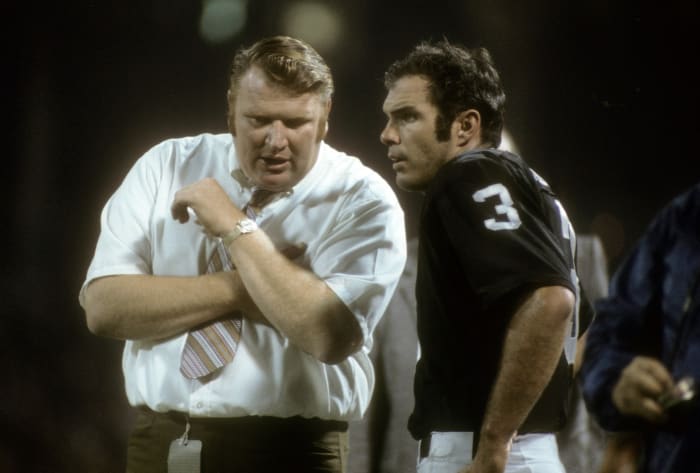
In what would be labeled preposterous roster management (by any team but the Packers) today, the Raiders drafted Ken Stabler in the 1968 second round but kept him on the bench for five seasons. Lamonica remained a quality quarterback, earning two AFL MVP nods and then Pro Bowl honors in the expanded NFL in 1970 and '72. John Madden had inserted Stabler late in the 1972 divisional-round game, better known for the Immaculate Reception, and he had led a game-winning drive. Lamonica still beat out Stabler for the '73 starting gig, but Madden made a change after a strong Stabler week of practice ahead of Week 4. The Canton-bound southpaw kept the gig for the decade's remainder.
Baltimore Colts: Johnny Unitas for Marty Domres (1972)

The Colts and Rams' owners, Carol Rosenbloom and Robert Irsay, traded franchises in 1972. This remains an underdiscussed NFL transaction, as it soon led to one of the all-time greats being demoted. Gearing up for a rebuild, a Colts team that had made the AFC title game in 1971 — after winning Super Bowl V a year prior — retooled by firing coach Don McCafferty and benching Unitas in the same week. A 21-0 Week 5 loss to the Cowboys marked the Colt legend's final Baltimore start, with Domres — a former Chargers top-10 pick in 1969 — taking over. Domres helped the Colts to a 4-5 finish, after they started 1-4, and the team traded Unitas to the Chargers in 1973.
Dallas Cowboys: Craig Morton for Roger Staubach (1971)
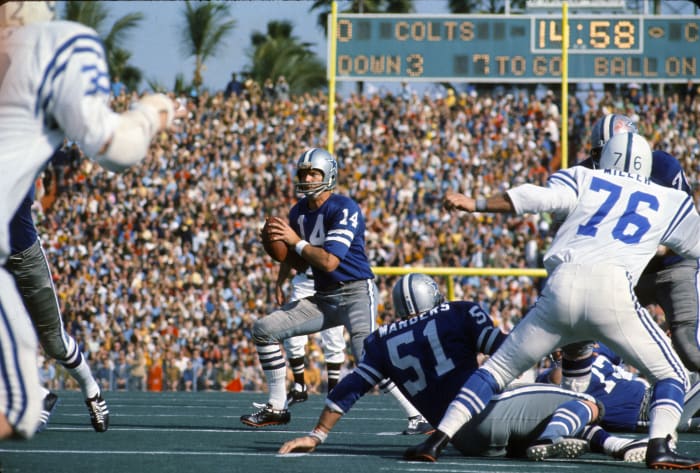
Tom Landry guided the Cowboys to Super Bowl V with Morton at the helm. A year later, the legendary coach could not decide between the incumbent or Staubach. A former Heisman winner who had completed his U.S. Navy service en route to joining the Cowboys in 1969, Staubach rotated starts with Morton during the season's first half. After using both QBs during the season's first six games, the innovative Landry devised a plan to rotate the passers every play in a Halloween loss to the Bears. After that, Landry picked Staubach, who went 13-0 as Dallas' starter en route to a dominant Super Bowl VI win. Morton still replaced an injured Staubach in 1972 but lost the job for good in '73.
San Francisco 49ers: Y.A. Tittle for John Brodie (1960)

Predating the Joe Montana-Steve Young position group by nearly 30 years, two future MVPs were part of the 49ers' QB room from 1957-60. Tittle had been the 49ers' starter for most of the 1950s, but the team chose Brodie third overall in the '57 draft. While Brodie received sporadic playing time, coach Red Hickey did not make the full-on change until Week 7 of the 1960 slate. Hickey's deployment of Brodie in his new shotgun formation, unveiled in a Nov. 27 game against the Colts, keyed Brodie's ascent. The 49ers traded Tittle to the Giants in August 1961, giving New York a Charlie Conerly successor. Title led the Giants to the NFL title game from 1961-63, winning MVP honors after a record-setting '63 season.
Sam Robinson is a sportswriter from Kansas City, Missouri. He primarily covers the NFL for Yardbarker. Moving from wildly injury-prone sprinter in the aughts to reporter in the 2010s, Sam set up camp in three time zones covering everything from high school water polo to Division II national championship games
More must-reads:
- Colts make decision on if Philip Rivers will start against Seahawks
- Steelers' Aaron Rodgers has hilarious reaction to Philip Rivers' return to NFL, Colts
- The 'Oldest 4,000-passing-yard seasons' quiz
Breaking News
Trending News
Customize Your Newsletter
 +
+
Get the latest news and rumors, customized to your favorite sports and teams. Emailed daily. Always free!
PRIVACY POLICY EDITORIAL POLICY CONTACT US
ABOUT YARDBARKER TERMS OF SERVICE
Use of this website (including any and all parts and
components) constitutes your acceptance of these
Terms of Service and Privacy Policy.
This site is for entertainment purposes only.
There is no gambling offered on this site.
Gambling Problem? Call 1-800-Gambler.




